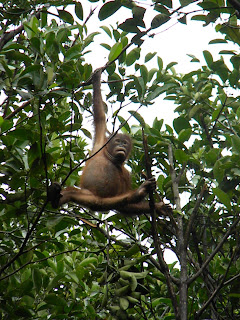 When they finally approached us, the orang utans didn’t head straight to the pile of fresh fruit on the small tree stand as I had expected. Instead they lingered in the trees thirty feet above us, playing and swinging back and forth for the next fifteen minutes. There were a few thin trees growing up through a square cutout in the viewing deck and these seemed to be the trees of choice for these two fellows, so they were literally directly over our heads. They weren’t swinging from one tree to another like we used to swing from the monkey bars on the school playground. Instead, they would climb to the top of one tall, thin tree and their weight would cause the tree to lean far in one direction. But then it would inevitably sway back and when the tree did so it would get the orang utan close enough so he could grab ahold of a neighboring tree. And so it went.
When they finally approached us, the orang utans didn’t head straight to the pile of fresh fruit on the small tree stand as I had expected. Instead they lingered in the trees thirty feet above us, playing and swinging back and forth for the next fifteen minutes. There were a few thin trees growing up through a square cutout in the viewing deck and these seemed to be the trees of choice for these two fellows, so they were literally directly over our heads. They weren’t swinging from one tree to another like we used to swing from the monkey bars on the school playground. Instead, they would climb to the top of one tall, thin tree and their weight would cause the tree to lean far in one direction. But then it would inevitably sway back and when the tree did so it would get the orang utan close enough so he could grab ahold of a neighboring tree. And so it went. Sometimes, though, they would just stay in the same tree and simply sway back and forth. The trees looked so thin, it seemed at times as if the weight of the orang utans might be too much and tree might snap in half. But of course, the orang utans never misjudged. They knew what they were doing. The orang utans seemed to be having a wonderful time and we were simply entranced.
Finally, having had enough of their youthful, tree-top play, the two orang utans made their way to the food platform and ate their late-morning breakfast.
Watching the two primates eat made us realize that it was close to lunch time and that we were pretty hungry ourselves. We climbed down from the viewing platform and returned to the Shangra La resort where we had some nasi lemak on one of their verandas which was made all the more enjoyable by the view overlooking the Pantai Dalit Bay.
-Jack
Watching the orang utans sway back and both high atop the thin trees looked like a ton of fun. A part of me wanted to be up there with them swaying back and forth, moving from one tree to the next. Over lunch, I shared my latest and greatest plan with my daughters.
Now that bungee jumping has worked its way into the mainstream, I decided it was time for the next extreme form of recreation. I painted a picture for my daughters of a large open air gym populated with tall, flexible reinforced graphite poles. Fee-paying thrill-seekers complete with a safety harness could sway from one “tree top” to the next. For a small fee, adrenaline junkies could know what it's like to be an orang utan swaying up among the tree tops.
Who knows, in order to market it to 18-35 year old males, maybe I’ll combine it with paintballing.















